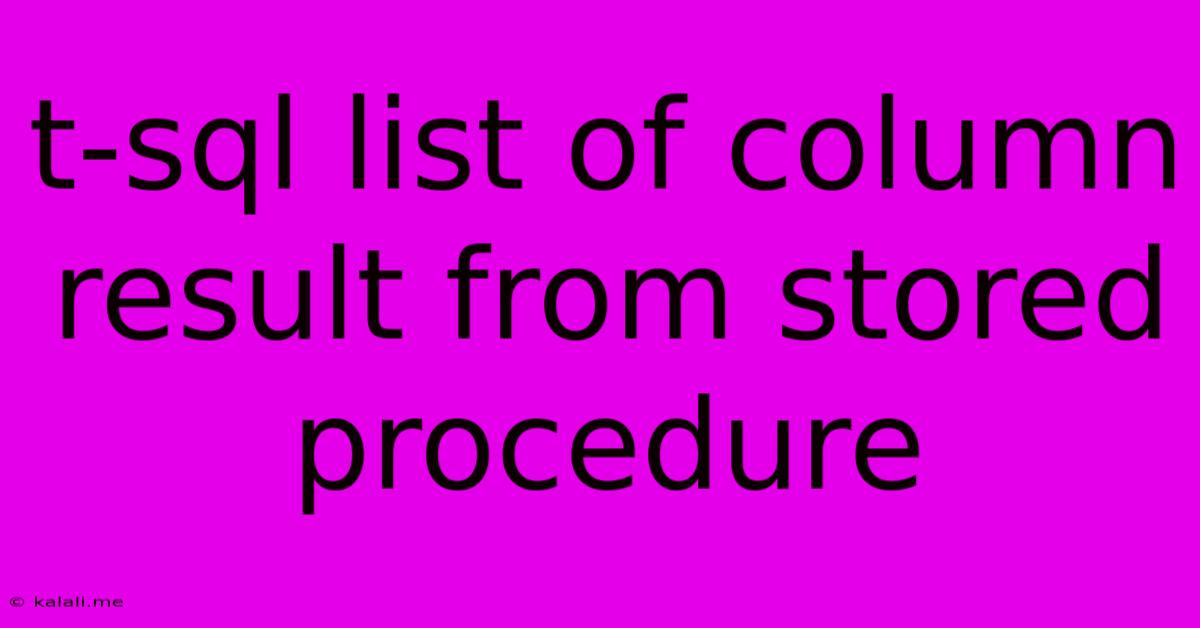T-sql List Of Column Result From Stored Procedure
Kalali
May 23, 2025 · 3 min read

Table of Contents
Retrieving a List of Column Names from a T-SQL Stored Procedure's Result Set
This article details several methods for obtaining a list of column names returned by a T-SQL stored procedure. Knowing how to retrieve this information is crucial for dynamic SQL generation, data processing applications, and understanding the output structure of your stored procedures. We'll explore techniques using system tables, metadata queries, and examining the result set directly within your application code.
Understanding the Challenge
Stored procedures often return result sets with varying structures. Directly accessing column names within the procedure itself is not always straightforward, particularly when the columns returned are dynamically determined. This makes extracting the column names a necessary step before processing the data.
Method 1: Using INFORMATION_SCHEMA Metadata
The INFORMATION_SCHEMA is a powerful database metadata repository. We can query it to retrieve information about the columns returned by a stored procedure. However, this approach requires knowing the procedure's name. This method is particularly useful when you have control over the stored procedure's definition and want to programmatically access its structure.
SELECT COLUMN_NAME
FROM INFORMATION_SCHEMA.COLUMNS
WHERE TABLE_NAME = 'YourProcedureName' -- Replace with your procedure name
Important Note: This approach directly queries the metadata and doesn't execute the stored procedure. It shows the defined columns, not necessarily the columns returned in every execution if the stored procedure uses dynamic SQL or conditional logic to determine its output.
Method 2: Executing the Stored Procedure and Examining the Result Set (Application-Level)
This method involves executing the stored procedure within your application code (e.g., C#, Java, Python) and then inspecting the resulting dataset's schema. Most database libraries provide methods to access column names directly from the result set object. The advantage here is that you get the actual columns returned by a specific execution.
- Example (Conceptual): Most database connectors offer methods to get column metadata directly from the result set after the stored procedure has been executed. This usually involves iterating through the returned columns and accessing their names. The exact implementation will vary depending on the specific programming language and database connector you are using.
Method 3: Dynamic SQL with sp_describe_first_result_set
For situations where you need the column names without knowing the exact structure beforehand, sp_describe_first_result_set offers a dynamic solution. This system stored procedure describes the result set of a given stored procedure. It's powerful for cases where the procedure's output changes dynamically.
EXEC sp_describe_first_result_set N'EXEC YourProcedureName'; -- Replace with your procedure name
This will return a result set describing the columns, including their name, data type, and other metadata. You can then process this result set to extract the column names.
Choosing the Right Method
The best method depends on your specific needs and context:
- Method 1 (INFORMATION_SCHEMA): Ideal for statically defined stored procedures where you need to know the column structure beforehand and have control over the procedure's definition. Useful for schema validation or documentation.
- Method 2 (Application-Level): Necessary when the stored procedure's output is dynamic or depends on runtime conditions. Provides the most accurate reflection of the actual result set.
- Method 3 (sp_describe_first_result_set): A robust approach for handling dynamically generated result sets where the column names aren't known in advance. Best suited for scenarios demanding adaptability.
Remember to replace "YourProcedureName" with the actual name of your stored procedure. By employing these techniques, you gain valuable control over understanding and manipulating the output of your T-SQL stored procedures. This knowledge is crucial for building efficient and robust database applications.
Latest Posts
Latest Posts
-
What Is 1 2 Equivalent To In Fractions
Jul 06, 2025
-
How Do You Say Pork In Spanish
Jul 06, 2025
Related Post
Thank you for visiting our website which covers about T-sql List Of Column Result From Stored Procedure . We hope the information provided has been useful to you. Feel free to contact us if you have any questions or need further assistance. See you next time and don't miss to bookmark.